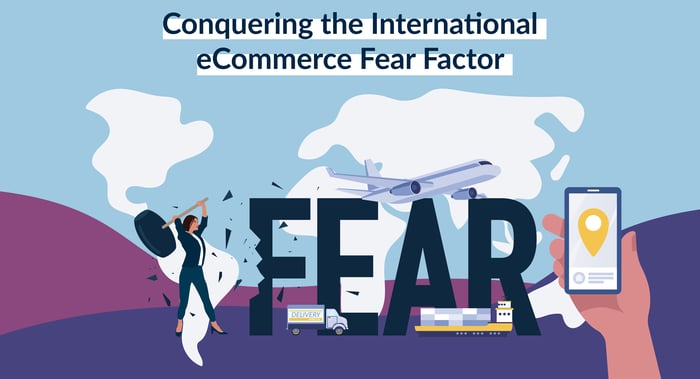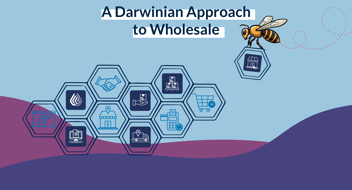CEO CORNER: Conquering the International eCommerce Fear Factor

Omphalophobia — fear of belly buttons
Arachibutyrophobia — fear of peanut butter sticking to the roof of your mouth
Hippopotomonstrosesquippedaliophobia — fear of long words
Globomerciaphobia — fear of international, cross-border ecommerce
OK, I’ll admit it — the last one is made up. There’s no phobia for selling internationally because by definition a phobia is an irrational fear, and expanding operations across borders is pretty scary. Cultural differences, customs regulations, and logistics are just a few of the challenges you’ll have to navigate when selling overseas.
But the thing is, once you assess the market, you’ll realize it really is worth facing up to your fears. Online retail sales are set to reach $6.51 trillion this year, and cross-border ecommerce is forecast to skyrocket from a market size of $893 billion in 2022 to $8.13 trillion by 2032.
A whopping 57% of online consumers currently shop internationally, and remember, 88% of shoppers prefer buying directly from a brand when given the choice. That means if you can find a way to sell through your website to international consumers — while avoiding many of the pitfalls of cross-border expansion — you’ll soon unlock new levels of profitability.
What You Need to Consider When Selling Internationally
Gone are the days when cross-border commerce was reserved for multinational conglomerates. Nowadays, specialty brands can’t afford to ignore the opportunities it presents. Still, before jumping in head-first, it’s important to consider the challenges that could arise along the way.
Customs
A 2023 survey by Statista asked supply chain professionals about the primary challenges they face in cross-border ecommerce. Topping the list were "shipments delayed in customs" with 43% of respondents highlighting it as a significant challenge, closely followed by "customs regulatory compliance" with 41.4% expressing concerns in this area.
Given that 99% of consumers consider fast delivery as an important factor, any delays caused by customs hold-ups could have a detrimental impact on customer loyalty towards your brand.
Taxes
Death and taxes — two certainties in this unpredictable world, right? Perhaps, but when you’re selling internationally, this “certainty” becomes worryingly unpredictable.
Even in the US, there’s debate about how state taxes are applied to ecommerce transactions. So, it’s inevitable that there’s even more confusion when you bring other countries’ legal frameworks into the mix.
According to the Statista survey I mentioned before, 26.6% of supply chain professionals classify “accurately calculating international duties and taxes” as their main challenge when engaging in international sales.
It’s no surprise really: when you cross over to other territories, there is a risk of subjecting your consumers to hidden taxes, and you may even find yourself receiving unexpected notifications from fiscal authorities.
Shipping Logistics and Returns
Shipping overseas isn’t cheap, so it’s understandable that “delivery costs” rank as the primary concern for 33.2% of supply chain experts.
And it’s not just about costs — selling overseas means a big step up in logistical complexity — and a wavering degree of reliability. I’ve seen brands struggle with the last mile domestically, so it’s of little surprise that many are having difficulties in other territories.
And what about returns? Well, for one, they’re not cheap. In the US, consumers sent back 47% of their online purchases in 2022. This frequency of returns can have a devastating impact, especially when you consider products worth $25 to $40 often lose 80-90% of their value in the returns process.
Returns aren’t just in vogue in the US — worldwide reverse logistics saw a significant increase of 13% between 2021 and 2022. When factoring in shipping costs, customs, documentation, and other factors, it figures that international returns are even more complex and costly. That’s probably why 26.6% of supply chain professionals identify the “cost of returns” as the main issue for companies selling cross-border.
Payment
While the almighty US dollar reigns supreme as the world’s primary reserve currency, it’s important to acknowledge that over 92% of online shoppers prefer to make purchases in their local currency.
What’s more, as well as a wide variety of currencies, there are a plethora of payment methods available in different countries. In Japan and Turkey, they largely pay with credit cards — but this isn’t the case everywhere. Only 30% of Germans even have a credit card, which may explain why Buy Now, Pay Later services are growing in use in Germany and Sweden. Further east, Indians prefer the convenience of cash on delivery, while digital wallets are all the craze in China.
Offering consumers their preferred payment option could give you a big boost in conversions, with 38% of cross-border shoppers saying they are more confident shopping internationally when their desired method is available.
Speaking of confidence, it’s important to consider the impact of fraud on international orders. It can be hard to spot when something is awry when you’re not familiar with a country’s payment processes, which is why fraud concerns more than 56% of cross-border businesses.
Pricing
When it comes to currency conversion, it’s worth doing your research — and considering the psychology of numbers in your target country.
In the United States, prices often end in the number 9, creating an illusion of lower prices for consumers. On the other hand, in China, the number 8 is considered lucky as it sounds similar to the word for wealth and prosperity — which is why you’ll see more prices ending in 8 there. Meanwhile, in Japan, they prefer to keep things simple and transparent for shoppers by using round numbers like 0 or 5.
Language and Localization
“Every Ford car has a high-quality corpse”
“Schweppes Toilet Water”
“The American Dairy Association: Are You Lactating?”
With 75% of international consumers wanting to buy products in their native language, and 59% rarely or never purchasing from English-only websites, making sure your website is accurately translated is imperative. As you can see above, it’s all too easy to get it horrendously wrong when translating directly!
Remember, localization goes beyond language alone. You may have to adjust your messaging, images, or even product variations to align with different cultural expectations.
Customer Support
Depending on what you’re selling, you might need to offer services such as setup, installation, or ongoing customer support. However, that’s easier said than done from another country and in a different language.
Considering that 50% of consumers switch to a competitor after one bad customer service experience, it’s vital not to lose market share thanks to not doing your due diligence on this one.
Websites
We all love to complain about our internet connection, but it’s worth keeping in mind that consumers in some other countries experience significantly slower speeds.
Your existing ecommerce site might look great and load quickly for domestic consumers, but it’s not necessarily the right fit for all overseas markets. Just a 0.1-second delay in loading times can lead to a 7% reduction in conversions. And if that delay extends to 1 second, it could negatively impact conversions by as much as 22%.
How to Sell Online Internationally
While transitioning to selling online in different territories is no walk in the park, with a few strategic adjustments, you could soon be looking at a profitable expansion to your domestic business.
First things first, you should consider decentralizing operations. Decentralization takes various forms and could involve anything from redirecting return packages to local warehouses rather than the point of origin to hiring staff in other territories with greater knowledge of local culture and customs.
As I mentioned before, it’s essential that you localize your website for each geography you're selling in. That means you’ll need a shopping cart specific to each territory’s language, currency, and culture, plus accurately translated copy on all of your web pages. And don’t forget to hook your website up with verification systems and other anti-fraud measures.
International shipping is always a big challenge, which is why you should aim to remove as much friction as possible. Utilizing third-party logistics (3PL) services can alleviate a great deal of stress by allowing you to ship to a local hub. 3PLs streamline the international shipping process for you by taking care of most of the paperwork and processes involved in exporting packages.
Some specialty brands aiming to avoid the difficulties associated with selling cross-border turn to international online marketplaces like Alibaba, AliExpress, Amazon FBA, Rakuten, and Flipkart. Given that 46% of international purchases are made via online marketplaces, on first impressions, this sounds like a great idea.
Unfortunately, it’s not as simple as that. Putting your products in the hands of these platforms frequently leads to increased competition and diminished profit margins. What’s more, they give you limited control over customer relationships and don’t provide you with the type of consumer data that you need to survive in today’s commerce landscape.
Cross-Border eCommerce Made Simple
By now, you’ve probably gathered that your fears of selling internationally from your website are not necessarily unfounded. But before you cover your eyes, consider this: There’s a simple way to tap into the cross-border ecommerce market that avoids all of the common challenges and pitfalls.
Quivers is the sophisticated Omnichannel Toolkit that empowers you to effortlessly sell online — whether that’s domestically or in other countries — without making significant changes to operations.
By utilizing Quivers, you leverage the power of your existing commerce ecosystem, including the retailers who carry your products, to fulfill orders placed on your websites. This means that if overseas wholesalers or domestic retailers who already sell abroad are ordering your products, you can conveniently bypass some of the more challenging aspects associated with cross-border ecommerce.
Support Your Commerce Ecosystem
As I mentioned in my last CEO Corner article, the relationship between brands and retailers should be symbiotic. When you use Quivers, you’re not just using your retail network — you’re also giving something back.
That applies just as much internationally as it does domestically: Overseas retailers who stock your products benefit from an additional sales channel and the chance to de-risk larger wholesale orders they place with your brand.
A Tool for Every Occasion
Quivers is a comprehensive software suite designed to facilitate international selling and provide a variety of popular fulfillment options including Buy Online, Pick Up In-Store (BOPIS), White Glove Delivery, and Ship-from-Store.
Before you dive into selling, you need the right website. Quivers HoverCart lets you easily launch multiple storefronts with different languages and currencies while keeping the same look and feel of your current site. Using just a simple line of code to create shoppable product pages, the lightweight nature of this tool ensures fast loading times regardless of connection speeds.
Quivers Pay provides comprehensive coverage for 100% of fraudulent orders. That means you can confidently accept payments from consumers worldwide without any risk or liability. While we sadly can’t offer “cash on delivery” as a payment option, Quivers Pay does support secure payment processing through PayPal, Google Pay™️, and Apple Pay®️.
Quivers even supports the use of local payment gateways, meaning you can connect with consumers by utilizing the payment gateway most popular in any new territory.
With global Buy Now, Pay Later (BNPL) transactions forecast to increase by over $450 billion worldwide between 2021 and 2026, Quivers Pay Later helps you tap into this expanding market with ease.
Given that 61% of BNPL users prefer to use a service offered directly on a brand’s website rather than go through a third party, the value of Quivers Pay Later is clear to see. And of course, Quivers covers all fraudulent transactions and guarantees all payments — regardless of consumer payment punctuality.
Special Delivery
As I mentioned earlier, using a 3PL provider can be a smart move when you’re moving into cross-border commerce. Still, it’s always better not to put all your eggs in one basket.
By leveraging the retailers who stock your products, you’re minimizing the logistical work you have to do — and making sure the people on the ground who are knowledgeable about your products are available to offer setup, installation, and customer support.
In addition to reducing delivery costs and simplifying the paperwork associated with international one-off orders, this approach ensures that returns are streamlined and facilitated at the local level — which means the process is as straightforward as possible.
With increasing consumer demand for cross-border shopping, specialty brands not wanting to miss the train need to act quickly. While the complexity of international ecommerce may seem daunting, it doesn’t mean you shouldn’t do it — but that you should do it right.
Thanks to Quivers, any fears you have of selling internationally can now be classified as irrational. And with that, the word globomerciaphobia now describes a real phobia.

.png?width=352&name=CEO%20Corner%20--%20Unified%20Commerce%20(2).png)

